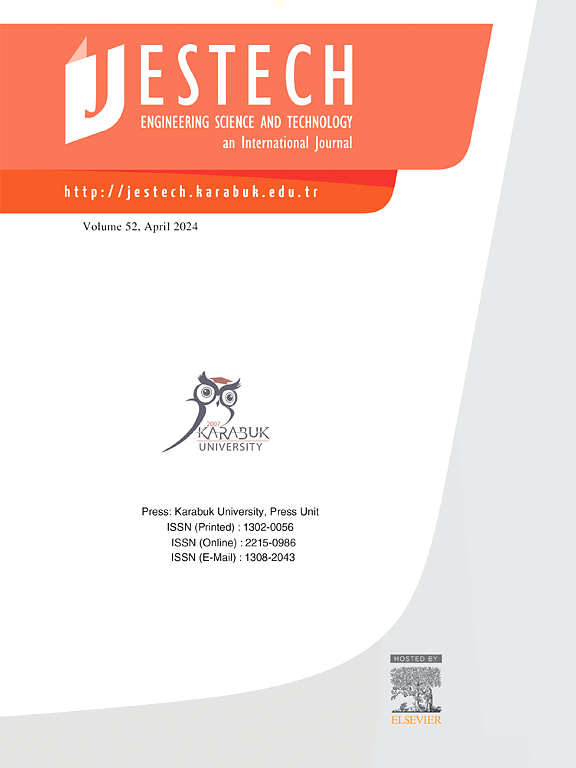A binary grasshopper optimization algorithm for solving uncapacitated facility location problem
IF 5.4
2区 工程技术
Q1 ENGINEERING, MULTIDISCIPLINARY
Engineering Science and Technology-An International Journal-Jestech
Pub Date : 2025-03-14
DOI:10.1016/j.jestch.2025.102031
引用次数: 0
Abstract
The Uncapacitated Facility Location Problem (UFLP) is a real-world binary optimization problem that aims to find the number of facilities to open, minimizing the total cost of exchange between customers and facilities, as well as the opening costs of these facilities. UFLP is classified as an NP-Hard problem. Metaheuristic methods are often preferred to solve UFLP due to their ability to find acceptable solutions in a reasonable time and its NP-Hard characteristics. Grasshopper Optimization Algorithm (GOA) is a continuous metaheursitics optimization algorithm. In the literature, although some binary versions of the GOA algorithm have been used to solve problems such as feature selection, knapsack, scheduling and cluster covering, its performance analysis has not been conducted on UFLP which is pure binary optimization problem. In this study, a novel binary version of the GOA integrated with a novel binarization procedure is proposed for solving the UFLP. In the binarization procedure, a probability-based update strategy has been developed for generating new candidate solutions. This approach ensures the probability of determining the effect of the global best solution on the candidate solution. Besides, during the population update phase, there are two different mechanisms to update the global best solution and other grasshoppers. To enhance diversity in the grasshopper population, an α parameter has been integrated into the original algorithm. It was aimed to improve the quality of the candidate solutions by the integration of the α parameter. The performance of the proposed algorithm is assessed on the CAP and M* datasets. The obtained GAP values for the CAP 71-CAP A, CAP B, and CAP C problems are 0, 0.14, and 0.18, respectively. The GAP is 0 for the MO1-MO5, MP2, MP3, and MQ1-MQ3 problems, and GAP ≤ 0.24 for the remaining problems. The results were compared with other state-of-the-art binary optimization algorithms. The experimental results show that the proposed method is superior to the other compared algorithms and is an effective algorithm for solving UFLPs.
求解无能力设施选址问题的二元蚱蜢优化算法
无容量设施选址问题(UFLP)是一个现实世界的二元优化问题,旨在找到要开放的设施数量,最小化客户和设施之间的总交换成本,以及这些设施的开放成本。UFLP被归类为NP-Hard问题。元启发式方法通常是解决UFLP的首选方法,因为它们能够在合理的时间内找到可接受的解决方案,并且具有NP-Hard特性。Grasshopper Optimization Algorithm (GOA)是一种连续的元启发式优化算法。在文献中,虽然使用了一些二进制版本的GOA算法来解决特征选择、背包、调度和簇覆盖等问题,但尚未对纯二进制优化问题UFLP进行性能分析。在这项研究中,我们提出了一种新的二进制版本的GOA,并结合了一种新的二值化方法来求解UFLP。在二值化过程中,开发了一种基于概率的更新策略来生成新的候选解。这种方法保证了确定全局最优解对候选解的影响的概率。此外,在种群更新阶段,有两种不同的机制来更新全局最优解和其他蝗虫。为了提高蝗虫种群的多样性,在原算法中加入了α参数。通过对α参数的积分来提高候选解的质量。在CAP和M*数据集上对该算法的性能进行了评估。获得的CAP 71-CAP A、CAP B和CAP C问题的GAP值分别为0、0.14和0.18。MO1-MO5、MP2、MP3和MQ1-MQ3问题的GAP为0,其余问题的GAP≤0.24。结果与其他最先进的二进制优化算法进行了比较。实验结果表明,该方法优于其他比较算法,是解决UFLPs问题的有效算法。
本文章由计算机程序翻译,如有差异,请以英文原文为准。
求助全文
约1分钟内获得全文
求助全文
来源期刊

Engineering Science and Technology-An International Journal-Jestech
Materials Science-Electronic, Optical and Magnetic Materials
CiteScore
11.20
自引率
3.50%
发文量
153
审稿时长
22 days
期刊介绍:
Engineering Science and Technology, an International Journal (JESTECH) (formerly Technology), a peer-reviewed quarterly engineering journal, publishes both theoretical and experimental high quality papers of permanent interest, not previously published in journals, in the field of engineering and applied science which aims to promote the theory and practice of technology and engineering. In addition to peer-reviewed original research papers, the Editorial Board welcomes original research reports, state-of-the-art reviews and communications in the broadly defined field of engineering science and technology.
The scope of JESTECH includes a wide spectrum of subjects including:
-Electrical/Electronics and Computer Engineering (Biomedical Engineering and Instrumentation; Coding, Cryptography, and Information Protection; Communications, Networks, Mobile Computing and Distributed Systems; Compilers and Operating Systems; Computer Architecture, Parallel Processing, and Dependability; Computer Vision and Robotics; Control Theory; Electromagnetic Waves, Microwave Techniques and Antennas; Embedded Systems; Integrated Circuits, VLSI Design, Testing, and CAD; Microelectromechanical Systems; Microelectronics, and Electronic Devices and Circuits; Power, Energy and Energy Conversion Systems; Signal, Image, and Speech Processing)
-Mechanical and Civil Engineering (Automotive Technologies; Biomechanics; Construction Materials; Design and Manufacturing; Dynamics and Control; Energy Generation, Utilization, Conversion, and Storage; Fluid Mechanics and Hydraulics; Heat and Mass Transfer; Micro-Nano Sciences; Renewable and Sustainable Energy Technologies; Robotics and Mechatronics; Solid Mechanics and Structure; Thermal Sciences)
-Metallurgical and Materials Engineering (Advanced Materials Science; Biomaterials; Ceramic and Inorgnanic Materials; Electronic-Magnetic Materials; Energy and Environment; Materials Characterizastion; Metallurgy; Polymers and Nanocomposites)
 求助内容:
求助内容: 应助结果提醒方式:
应助结果提醒方式:


